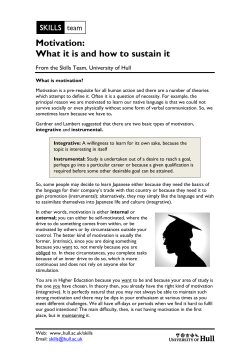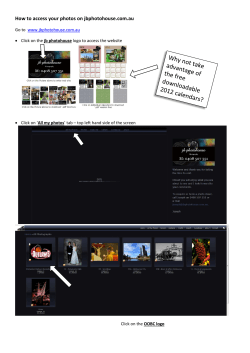
How to design a scalable flipped classroom A/Professor Carl Reidsema
How to design a scalable flipped classroom A/Professor Carl Reidsema Dr Abelardo Pardo Workshop Outline • 1st hour - Whole Systems Design • Break (30 mins) • 2nd hour - Implementation Issues Opening the conversation … Your thoughts + Our experiences + Context considerations = Next steps/ further conversations A definition – perhaps too tight? The flipped classroom describes a reversal of traditional teaching where students gain first exposure to new material outside of class, usually via reading or lecture videos, and then class time is used to do the harder work of assimilating that knowledge through strategies such as problem-solving, discussion or debates. (Vanderbilt University, Centre for Teaching/TEDI). Question Why would YOU want to deploy a Flipped Classroom? • • • • • • Correct misconceptions Increase conceptual depth Integrate depth with breadth Improve on-campus engagement in learning Reallocation of staff to high value tasks? Taking advantage of online learning resources Why? http://www.flickr.com/photos/joefruchey/4304930267 Paradigm changes Roles and expectations: – Students MUST take responsibility: Ownership of learning – Teachers MUST take facilitation roles And there’s a narrative that evolves out of this – a shared meaning/ relevance Questions What are the implications of: 1. Changing expectations of students 2. Changing roles of staff 3. Building on the online resources in class a. Concept exploration b. Demonstration/ Application c. Meaning making Flipped Classroom Design Considerations People-Spaces-Tools Design CONTEXT CURRICULUM FLIP Course NARRATIVE Content Learning Objectives Activities Assessment Communication EVALUATION 1. Learning Outcomes 2. Shared understanding 3. Ownership of learning Course DRIVERS: • Institution/ Management • Academics/ Students • Industry • Technology • Global trends CURRICULUM Measure Red Hat Conversation Do you feel daunted/ pressured/ excited at the prospect of flipping your classroom? Workshop Approach to Engage Staff So who did the pre-work? • • • • • It takes more time than you think. Use other people’s stuff. Expect push-back from students. Keep your options open. Have a plan for your extra class time – that’s the point! John Sowash: http://www.youtube.com/watch?v=4JPdGlyt6gg Key Aspects from the Podcasts Aspects to apply to your context Key Aspects • • • • • • Upfront planning/design takes time and thought Complex systems approach Ownership of Learning Importance of Context Importance of Narrative Putting content online is only a small part Let’s map your context (10 mins) Institutional Context Course Design/ Delivery Instructor Characteristics Student Characteristics The institutional factors affecting the way that the course is implemented: The topic focus, resources, and, technology used The experience and attitudes of the instructor Experiences, expectations and attitudes of the students • type of institution; • institutional values; and • Reputation How content is delivered (read/ watch – discuss/ create – explore/ evaluate) Cohort size and diversity Level of prior knowledge Learner granularity (individual, group, team) Community Expectations Learning Objectives Instructor Motivation Student Motivation The expectations of evaluators: What changes in student knowledge and skills are expected The support and rewards available to the instructor The kinds and levels of effort and interest that students put into the course • accrediting bodies, • industry, • funding bodies etc. Level of ownership Rewards for doing well Curriculum Context Assessment Teacher Behaviours Student Behaviours Factors affecting the status, purpose and perceptions of the course within its program context Nature and weightings of assessment tasks, and the nature of the criteria (recall – synthesise – create) Teacher decisions, attitudes, and interactions (sage on stage – guide on side – co-traveller) The nature and amount of student participation in the course including how much they focus on topics, processes, and products Student support – tutors, email response etc. ENGG1200 – Engineering Modelling and Problem Solving– Semester 2, Year 1 Institutional Context Course Design/ Delivery Instructor Characteristics Student Characteristics • • • • • • • • • • Public funded/research intensive Ranked 2nd (Australia) and in the top 100 internationally 100 years old Recent edX member 1200 students enrolled annually in engineering Teaching Focused (TF) academic program Strong but informal SOTL strength in engineering and science • • • Engineering Modelling and Problem Solving through authentic team based major design/build projects Flipped Class mode with engineering materials concepts delivered through online videos Entirely active learning/no lectures Balanced individual/team learning • • • • • Professorial leadership with extensive industry experience Award winning TF academics Learner/student focused Change agents Project leaders and tutors carefully selected – enthusiasm, desire to work with first years, ability to challenge students Teaching team ~40 • • • • • 100% transfer from ENGG1100 with similar demographics Multiple engineering disciplines Mix of engineering statics, thermo, electrical fundamentals Mix of 1st year maths ability Improved social networks Improved conceptions of degree major Community Expectations Learning Objectives Instructor Motivation Student Motivation • • • • • • Engineers Australia (EA) Emphasis on theory-practice, critical thinking, engineering ability Grow Industry funding through student project sponsorship (Boeing, ABB, Barnes Foundation etc.); • • • • • Appreciation of mathematical/virtual/physical modelling Application of engineering materials behaviour in design Demonstrated ownership of learning Reflective writing for design thinking and planning Effective team skills Use of design process • • • Largely intrinsic rewards for degree of effort High probability of promotion through change leadership Opportunity to engage in research around design learning and transformational change High degree of ownership but significant teaching team autonomy • • • • Still predominantly strategic learners Strong desire for authentic learning and experiences Seeking relevance Developing levels of ownership and identity Critical team players Curriculum Context Assessment Teacher Behaviours Student Behaviours • • • • • • • • • Emphasis on teaching as • • • • • Course Evaluation results EA commendation Academic conceptions of technical rigour Industry recognition National awards received Balance research intensive image with real world authentic learning • Varied assessment types Online MCQ/written reflections Team design reports Structured activity templates Demonstration of final designed product performance Team peer review • • • • facilitation and coaching Emphasis on experiential learning Extensive use of PG/UG tutors Extensive use of Facebook/email/LMS communication modes Strong emphasis on developing student’s agency • • • Predominantly strongly motivated Mixed cohort of epistemological developmental levels (3-4 Perry) Accepting of challenges Struggle with teaching vs learning High degree of participation Black Hat Conversation What are the immediate obstacles? What are the long-term problems? Write on sticky notes and then categorise (make new category if necessary): 5 mins Let’s take a break Gradual Strategy People Spaces Technology www.flickr.com/photos/93877181@N00/4905173357/ Sustainable FC Implementation People www.flickr.com/photos/93877181@N00/4905173357/ Sustainable FC Implementation • • • • Take ownership of their learning Clearly informed of expectations Additional scaffolding required Detailed feedback on progress http://www.flickr.com/photos/joefruchey/4304930267 People - Students • • • • • Institutional support to active learning Clear vision of how to deploy FC Transition from traditional lectures Suggest gradual approach Promote best practices (projects, grants) http://www.flickr.com/photos/joefruchey/4304930267 People - Instructors Anticipate obstacles • More time • Useful? • Not an improvement http://www.flickr.com/photos/hisgett/6940877193 People - Instructors Empower people People Vision Experts Project leaders E-Learning Student - driven http://www.flickr.com/photos/90585146@N08/8222922317 People - Instructors http://www.flickr.com/photos/nicmcphee/279625345/ People - Instructors Learning by doing People - Others • • • Admin support Tech support Professional development team http://www.flickr.com/photos/joefruchey/4304930267 What is the #1 action for your “people”? www.flickr.com/photos/93877181@N00/4905173357/ Spaces http://www.flickr.com/photos/pahudson/5514887224/ Spaces to prepare Spaces to interact Be creative: Find spaces Be creative: Find spaces Spaces to interact Outdoors? Old spaces, new activities http://www.flickr.com/photos/joefruchey/4304930267 What is the #1 action regarding spaces? Technology www.flickr.com/photos/93877181@N00/4905173357/ Sustainable FC Implementation Use technology To bind together … … for content … http://www.ozteacher.com.au/technology/technology-in-schools/cheat-sheet-a-beginners-guide-totutorial-videos-and-screencasting/25038 communication and management. • Createams – purposeful team selection • WebPA – peer assessment • Teamwork in Action – team training ALL LINKED TO BLACKBOARD – our institutional LMS http://www.flickr.com/photos/joefruchey/4304930267 What is the #1 technological action? So returning to … People-Spaces-Tools Design CONTEXT CURRICULUM FLIP Course NARRATIVE Content Learning Objectives Activities Assessment Communication EVALUATION 1. Learning Outcomes 2. Shared understanding 3. Ownership of learning Course DRIVERS: • Institution/ Management • Academics/ Students • Industry • Technology • Global trends CURRICULUM Measure Yellow Hat Conversation Where to next? What are the opportunities? How will this all get done? Thank you! Example: Designing a new course Concept Mapping of Engineering Materials – What students need to know – What students need to do (to demonstrate attainment) Example: a template session Start with learning outcomes … Example: a practical session Example: Owning Learning through reflection R1: What are your goals? R2: Project Management R3: Check your theory R4: Modelling R5: Goal Check Example – University of Sydney • ELEC1601 Fundamentals of Computer Systems • First year, second semester Engineering • Enrollment: ≈300 students. Sessions with Previous and in-class activities Clear statement of that is needed Videos to support activities MCQ to guarantee engagement Report engagement to staff
© Copyright 2025

















